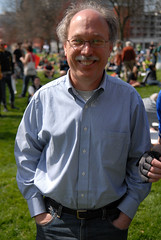Joe Cortright, an economist with Impresa Inc. and the senior policy advisor for urban planning think tank CEO for Cities, says engineers and planners have dumped billions of dollars into sprawl-inducing roads and highways in part based on a “deeply flawed metric” that’s been an industry standard for 25 years.
Released today, Cortright’s report, Driven Apart: How Sprawl Is Lengthening Our Commutes and Why Misleading Mobility Measures Are Making Things Worse, takes aim at the Urban Mobility Report (UMR) a metric created by the Texas Transportation Institute 25 years ago. Cortright says the UMR is a flawed tool because it only looks at travel times and does not take into account trip distances.
“We need a new set of measures that emphasize accessibility and choice, rather than simply automobile speed.”
The chief measurement in the UMR is known as Travel Time Index (TTI), the ratio of average peak hour travel times to average free flow travel times. Here’s an example from the report: A trip that takes 20 minutes in free flow conditions is estimated to require, on average, 25 minutes during peak travel times, giving it a TTI score of 1.25 (the higher the score the worse travel conditions are thought to be).
Cortright argues that we should be focused on total travel times (not just peak and free-flow) in order to set public policy on urban transportation problems. If more planners did that, Cortright says, there would be a larger priority put on improving land-use patterns, access to transit, and creating neighborhoods that are good for walking and biking.
Reached today, Cortright said that the UMR has been used for decades, “to beat the drum about the horrors of urban traffic congestion, and argue for more highway capacity… And it’s structured in a way that rewards sprawl and penalizes compact development.” Cortright calls for a new set of measures that, “Emphasize accessibility and choice, rather than simply automobile speed.”
According to Cortright, the key is to focus on policies that encourage shorter trips, which reduce peak period travel times (he lists a five-point plan for a new system in the report, which you can download here). This issue, he says, also strikes at the heart of the role cities play in bringing people together. From the report (emphasis mine):
“The essential economic and social purpose of cities is bringing people together, taking advantage of opportunities for interaction and agglomeration economies. Cities perform this function in two principal ways, by providing accessibility (putting people close to one another and to common destinations), and through mobility, the ability to move easily from one point to another. National discussions of how to make cities work better have tended to focus on making it easier for people to move, which has had the paradoxical effect of leading cities to be less dense. And the measures we use to describe how well city transportation systems work have reflected this bias toward mobility. In that sense, the emphasis on mobility measures has driven us apart. Putting more emphasis on accessibility can bring us closer together.”
The Driven Apart report was commissioned by CEOs for Cities and supported by the Rockefeller Foundation. Download the executive summary and learn more at the CEOs for Cities website.


